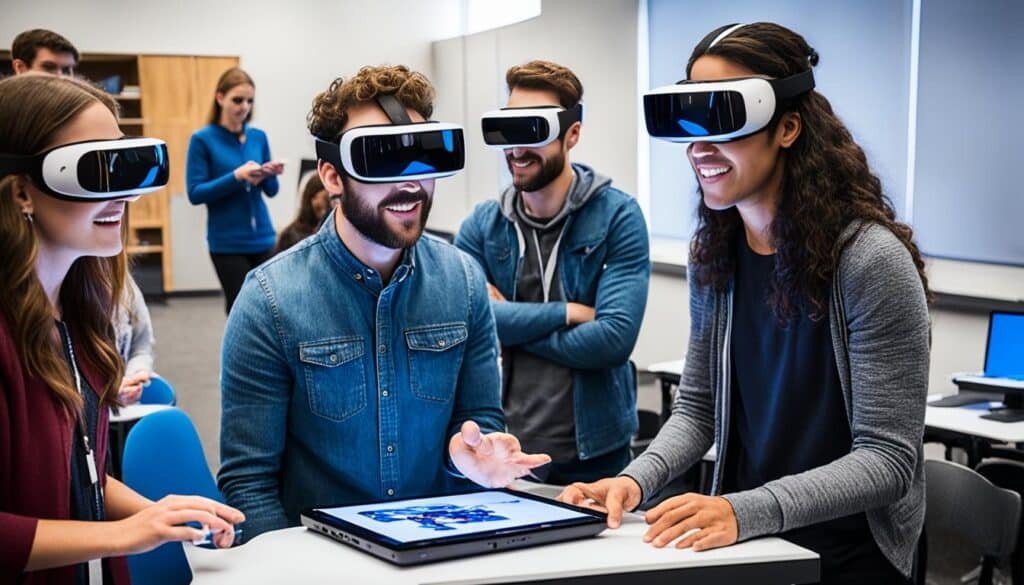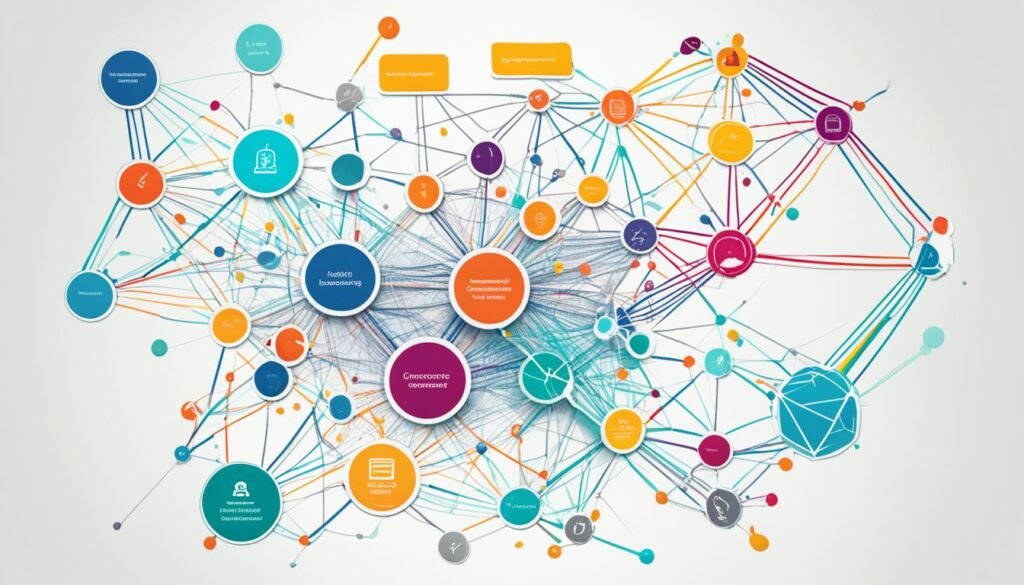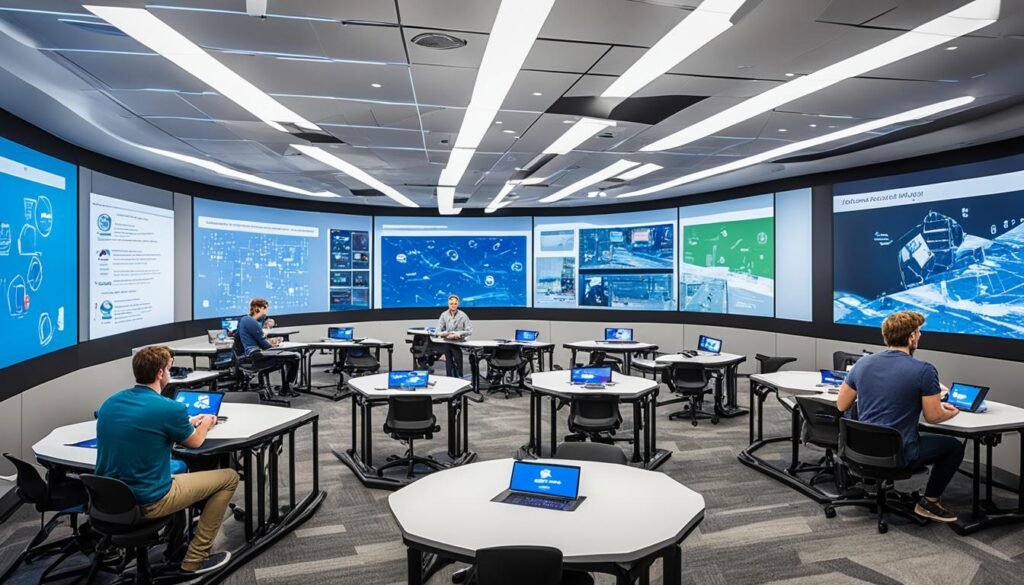The digital learning revolution is transforming the educational landscape, driven by the remarkable advancements in instructional technology. Instructional design and learning experiences are at the forefront of this transformation, as educators and institutions explore innovative ways to leverage technology to enhance the learning process.
At the heart of this revolution lies the K-12 Digital Learning Revolution Program, a collaborative effort by 70+ 1EdTech Consortium member school districts and state departments of education, representing over 11 million students. This program enables a straightforward evolution to digital learning and provides the foundation for making significant advancements in teaching and learning.
The program offers various tiers to meet the specific needs of districts, from establishing a plug-and-play digital ecosystem to gaining advanced insights into student learning experiences and improving instructional impact. By providing resources, support, and networking opportunities, the program ensures the successful implementation of instructional technology innovations that enhance the learning process and outcomes.
Key Takeaways
- The K-12 Digital Learning Revolution Program is a collaborative effort by over 70 school districts and state departments of education, representing 11 million students.
- The program offers various tiers to meet the specific needs of districts, from establishing a digital ecosystem to gaining insights into student learning experiences.
- The program provides resources, support, and networking opportunities to ensure successful implementation of instructional technology innovations.
- Instructional design and learning experiences are at the forefront of the digital learning revolution, as educators explore ways to leverage technology.
- The program enables a straightforward evolution to digital learning and lays the foundation for advancements in teaching and learning.
The Rise of Digital Education
Digital education has witnessed significant advancements in recent years, transforming the way we learn and teach. As technology continues to evolve, innovative solutions are emerging that are reshaping the educational landscape.
Virtual and Augmented Reality for Immersive Learning
Virtual and augmented reality (VR and AR) technologies are poised to revolutionize digital education by offering immersive learning experiences. These technologies allow students to explore virtual environments, conduct simulations, and engage with digital content in a way that transcends the traditional classroom setting. By providing a new dimension of interactivity and engagement, VR and AR have the potential to make learning more memorable and transformative.
Artificial Intelligence and Machine Learning for Personalized Instruction
The integration of artificial intelligence (AI) and machine learning (ML) is enabling personalized learning experiences for students. Intelligent tutoring systems can adapt to individual learning styles and provide customized learning paths, ensuring that each student receives the support they need to succeed. AI-powered chatbots can also assist students in real-time, answering questions and providing guidance to cater to their unique needs.
Gamification to Boost Engagement and Motivation
Gamification is gaining traction as a powerful tool to enhance student engagement and motivation. By incorporating game elements such as points, badges, leaderboards, and rewards, digital education platforms can create a more interactive and entertaining learning experience. This approach not only fosters healthy competition but also encourages collaboration and provides immediate feedback, ultimately making the learning process more engaging and educational.
Transforming Traditional Learning Methods

In modern classrooms, digital tools have become indispensable, transforming traditional learning methods. Interactive technologies like smart whiteboards and digital textbooks have replaced traditional blackboards and books, creating an engaging and dynamic learning environment. The use of educational apps and online resources has further enhanced the teaching process, allowing educators to deliver lessons in more interactive and impactful ways.
Interactive Technologies in Modern Classrooms
The integration of interactive technologies in modern classrooms has revolutionized the learning experience. Smart whiteboards, with their touch-sensitive screens and multimedia capabilities, enable teachers to create more engaging and dynamic lesson plans, incorporating multimedia content and interactive exercises. Similarly, digital textbooks have replaced traditional print materials, offering students a more immersive and interactive learning experience, with embedded videos, simulations, and assessment tools.
Preparing Students for a Digital Future
As digital literacy becomes as critical as traditional literacy, preparing students for a digital future is a fundamental goal of education. This involves equipping students with the necessary technical skills, as well as critical thinking, problem-solving, and adaptability skills essential for success in the 21st century. By integrating digital tools and online resources into the teaching process, educators can ensure that students are well-equipped to navigate the digital landscape and thrive in the technology-driven future.
Challenges in Integrating Technology in Education
![]()
Integrating technology in education requires addressing significant challenges. One of the primary concerns is ensuring equitable access to digital tools, as underserved areas may lack affordable devices and reliable internet connectivity. Collaborative efforts between educational institutions, governments, and tech companies are essential to provide school subsidies, grants, and infrastructure development to address this issue.
Ensuring Equitable Access to Digital Tools
Ensuring that all students have access to the necessary digital tools and resources is a crucial challenge in integrating technology in education. Underserved areas, particularly those with limited financial resources, often face barriers to acquiring affordable devices and maintaining reliable internet connectivity. To overcome this challenge, educational institutions, governments, and tech companies must work together to develop targeted programs that provide school subsidies, grants, and investments in infrastructure development.
Cybersecurity and Data Privacy Concerns
As educational institutions increasingly rely on digital platforms and tools, cybersecurity and data privacy concerns have become paramount. Tech companies can play a vital role in addressing these challenges by offering tailored cybersecurity solutions and conducting workshops on data privacy and security protocols. Educating administrators and educators on best practices for data protection and secure technology use is essential to safeguarding sensitive student information.
Training Educators on New Technologies
Effectively integrating technology in the classroom requires that educators be equipped with the knowledge and skills to utilize the latest educational technologies and teaching methodologies. Continuous training programs, developed in partnership with tech companies, are essential to ensure that educators can effectively leverage digital tools to enhance the learning experience. These programs should provide comprehensive training, certification opportunities, and ongoing support to help educators stay up-to-date with the evolving landscape of instructional technology.
Governments can also play a crucial role in addressing these challenges by creating policies and providing funding to support technology integration and research in edtech solutions. By fostering collaborative efforts between stakeholders, educational institutions can ensure that the integration of technology in education is both technologically advanced and pedagogically sound, ultimately leading to more relevant and effective learning experiences for students.
Collaborative Efforts for Effective Integration

Effective integration of technology in education requires a collaborative approach involving various stakeholders. Educational institutions and governments should partner to provide equitable access to digital tools, initiating programs for affordable devices and reliable internet connectivity in underserved areas. Collaborating on cybersecurity is also vital, with tech companies offering tailored solutions and conducting workshops for educators and administrators.
Partnerships Between Institutions, Governments, and Tech Companies
Continuous training programs for educators, developed in partnership with tech companies, can ensure they are equipped to effectively utilize the latest educational technologies and teaching methodologies. Tech companies can also work with educators to develop curricula that meaningfully integrate technology, ensuring the tools provided are technologically advanced, pedagogically sound, and relevant to current educational needs. Governments can play a crucial role by creating policies and providing funding to support technology integration and research in edtech solutions.
Developing Tailored Curricula and Educational Solutions
Tech companies can collaborate with educators to create tailored curricula and educational solutions that effectively integrate technology. This ensures the tools and resources provided are technologically advanced, pedagogically sound, and relevant to the current educational landscape. By working closely with educational institutions, tech companies can develop curricula that meaningfully incorporate technology, enhancing the learning experience for students.
Instructional Technology: Redefining Learning Experiences

Instructional technology is redefining the learning experience in various ways. Adaptive learning platforms leverage data analytics and AI algorithms to personalize instruction based on individual learner needs. These platforms analyze learner performance, preferences, and behaviors to dynamically adjust the content, pace, and difficulty level, ensuring optimal learning outcomes for each student.
Adaptive Learning Platforms
These innovative platforms utilize personalization, data analytics, and AI algorithms to provide individualized instruction tailored to the unique needs of each learner. By closely monitoring learner performance, preferences, and behaviors, adaptive learning platforms can make dynamic adjustments to the content, pace, and difficulty level, ensuring optimal learning outcomes for every student.
Collaborative Learning Tools
Collaborative learning tools, such as virtual classrooms and group assignments, enable students to work together, share resources, and engage in discussions regardless of their physical location. These tools foster teamwork, communication, and critical thinking skills, preparing students for the collaborative work environments of the future.
Mobile Learning for On-the-Go Education
Mobile learning, with its ability to provide access to educational content anytime and anywhere, offers flexibility and convenience to learners. Features like offline learning capabilities, push notifications, and mobile-friendly interfaces ensure uninterrupted learning experiences on the go, empowering students to learn at their own pace and on their own schedule.
| Adaptive Learning Platforms | Collaborative Learning Tools | Mobile Learning |
|---|---|---|
| Personalized instruction based on learner data | Virtual classrooms and group assignments | Access to educational content anytime, anywhere |
| AI-powered dynamic adjustments to content, pace, and difficulty | Fosters teamwork, communication, and critical thinking | Offline learning, push notifications, mobile-friendly interfaces |
| Optimized learning outcomes for each student | Prepares students for collaborative work environments | Flexibility and convenience for learners |
Data Analytics and Learning Analytics

Data analytics and learning analytics play a pivotal role in understanding learner progress, performance, and behaviors. Digital education platforms leverage these analytics to gain insights into areas of improvement, track learning outcomes, and make data-driven decisions. Educators can identify struggling students, evaluate instructional strategies, and personalize learning pathways, resulting in more effective teaching and improved student outcomes.
Gaining Insights into Student Progress and Performance
By analyzing learner data, educators can make informed decisions to enhance instructional strategies and create personalized learning experiences that cater to the unique needs of each student. This understanding of learner progress and student performance allows educators to identify areas in need of improvement and adjust their teaching methods accordingly.
Improving Instructional Strategies and Personalized Learning Pathways
The insights gained from data analytics and learning analytics empower educators to evaluate instructional strategies and develop personalized learning pathways that cater to the specific needs of each student. This data-driven approach enables educators to track learning outcomes, personalize learning, and ultimately deliver more effective teaching, leading to improved student outcomes.
Upcoming Features in Digital Education

The future of digital education holds exciting features on the horizon. One such development is the rise of microlearning, the delivery of educational content in short, bite-sized modules. This approach caters to shorter attention spans and ensures easy consumption and retention of information. Concise and focused lessons can be accessed and completed quickly, providing a more efficient learning experience for students.
Microlearning
Microlearning modules, often lasting just a few minutes, offer several advantages. They are easy to consume and retain, accommodating the modern learner’s attention spans. These concise, focused lessons can be seamlessly integrated into the daily routine, making the learning process more manageable and engaging.
Artificial Intelligence Grading
Another upcoming feature in digital education is the use of artificial intelligence (AI) for grading. AI-powered systems can analyze student work and provide instant feedback and grades, offering several benefits. This technology enables faster grading times, ensuring more objective assessments. Importantly, it frees up valuable teacher time, allowing them to focus on other essential tasks, such as lesson planning and student support.
The integration of these innovative features, from microlearning to AI grading, represents the ever-evolving landscape of digital education. As technology continues to shape the learning experience, these upcoming advancements promise to enhance the ease of consumption, retention, and efficiency of educational content, while also empowering educators to provide more personalized support and nurture the development of essential skills.
Overcoming Challenges through Collaboration

Overcoming the challenges of integrating technology in education requires a collaborative approach involving various stakeholder groups. Educational institutions and governments should partner to provide equitable access to digital tools, initiating programs for affordable devices and reliable internet connectivity. Collaborating on cybersecurity and data privacy is also crucial, with tech companies offering tailored solutions and conducting workshops.
Continuous training programs for educators, developed in partnership with tech companies, can ensure they are equipped to effectively utilize the latest educational technologies. Tech companies can also work with educators to develop curricula that meaningfully integrate technology. Governments can play a vital role by creating policies and providing funding to support technology integration and research in edtech solutions.
Effective collaboration among these stakeholder groups is essential for the successful integration of instructional technology in education.
| Stakeholder Group | Collaborative Efforts |
|---|---|
| Educational Institutions | – Partner with governments to provide equitable access to digital tools – Collaborate on cybersecurity and data privacy |
| Governments | – Create policies to support technology integration and research – Provide funding for edtech solutions and infrastructure development |
| Tech Companies | – Offer tailored cybersecurity solutions and conduct workshops – Develop continuous training programs for educators – Work with educators to create meaningful curriculum integration |
The Future of Digital Education

The future of digital education holds immense promise, with technology continuing to shape and transform the learning landscape. Emerging technologies, such as virtual and augmented reality, adaptive learning platforms, collaborative tools, mobile learning, and data analytics, will play a crucial role in broadening access to education, enhancing engagement and interactivity, and fostering inclusive and imaginative learning experiences.
Broadening Access to Education
Advancements in personalized learning, microlearning, and AI-powered grading will further improve the efficiency and effectiveness of the educational process. Collaborative efforts to ensure equitable access to digital tools and reliable infrastructure, as well as the development of engaging, interactive, and adaptable learning experiences, will be essential in creating a more inclusive and imaginative future for digital education.
Enhancing Engagement and Interactivity
The integration of virtual reality and augmented reality technologies will immerse learners in captivating and memorable educational environments, while adaptive platforms and collaborative tools will foster a sense of teamwork, communication, and critical thinking. Mobile learning will provide learners with the flexibility and convenience to access educational content anytime and anywhere, empowering them to learn at their own pace and on their own terms.
Fostering Inclusive and Imaginative Learning Experiences
The future of digital education will prioritize the creation of inclusive and imaginative learning experiences, tailored to the unique needs and preferences of each student. Data analytics and personalized pathways will enable educators to make data-driven decisions and deliver efficient, adaptable, and customized instruction, ensuring objective assessments and optimal learning outcomes.
Embracing the Digital Learning Revolution

The digital learning revolution is transforming education, reshaping traditional methods and paving the way for greater educational inclusion and future readiness. Instructional technology plays a dynamic role in this transformation, redefining how we learn, teach, and interact in the digital age. As digital literacy becomes as crucial as traditional literacy, preparing students with the necessary 21st century skills, such as critical thinking, problem-solving, and adaptability, is a fundamental goal of this revolution.
Embracing the digital learning revolution requires collaborative efforts among various stakeholder groups, including educational institutions, governments, and tech companies. By working together to ensure equitable access to digital tools, address cybersecurity and data privacy concerns, develop tailored training programs for educators, and create policies and funding to support technology integration and research, these stakeholders can unlock the full potential of edtech and drive transformative learning experiences.
| Stakeholder Group | Collaborative Efforts |
|---|---|
| Educational Institutions | – Ensure equitable access to digital tools – Develop tailored training programs for educators – Work with tech companies to integrate technology into the curriculum |
| Governments | – Create policies to support technology integration in education – Provide funding for research and implementation of innovative edtech solutions – Collaborate with educational institutions and tech companies to address cybersecurity concerns |
| Tech Companies | – Offer tailored cybersecurity solutions for educational institutions – Develop training programs to help educators effectively utilize educational technologies – Partner with educational institutions to create technology-driven curriculum and learning experiences |
Also Read: Beyond Roads: Advancements In Transportation Technology
Conclusion
The digital learning revolution is ushering in a transformative era for education, driven by the remarkable advancements in instructional technology. From immersive virtual and augmented reality experiences to personalized adaptive learning platforms and collaborative learning tools, the future of education holds boundless possibilities. By embracing this digital transformation and fostering collaborative efforts among key stakeholders, we can ensure equitable access to digital resources, enhance engagement and interactivity, and create inclusive learning experiences tailored to the unique needs of each student.
The integration of data analytics and AI-powered features will further empower educators to make data-driven decisions, improve instructional strategies, and foster the development of essential 21st century skills. As we continue to harness the power of technology, the digital learning revolution promises to redefine the educational landscape, preparing learners for the challenges and opportunities of the future. By leveraging the power of instructional technology, we can unlock transformative learning experiences that pave the way for a more inclusive and future-ready education system.
Through collaborative efforts and a commitment to innovation, the digital learning revolution can create a more equitable, personalized, and engaging educational landscape. By harnessing the potential of technology-driven innovation, we can empower learners, embolden educators, and redefine the future of education. As we move forward, the digital learning revolution stands as a beacon of promise, illuminating the path towards a more transformative and inclusive learning experience for all.
FAQs
Q: What is instructional design and how does it relate to digital learning?
A: Instructional design is the process of creating effective learning experiences using technology to improve learning outcomes. It encompasses learning design, theory and practice, and the role of technology in facilitating learning.
Q: What are some examples of learning technologies in the digital learning revolution?
A: Learning technologies used in digital learning include learning management systems, online courses, distance learning platforms, and various tools for instructional delivery and enhancing learning.
Q: What are the benefits of instructional technology in education?
A: Instructional technology offers educators and learners the ability to enhance the learning process, create engaging online experiences, and achieve learning objectives more effectively.
Q: How can instructional technology resources support the design and development of digital learning solutions?
A: Instructional technology resources provide instructional designers and educators with tools and platforms to design, develop, and implement online learning experiences and degree programs.
Q: What is the role of technology in the field of instructional design and development?
A: Technology plays a crucial role in instructional design and development by enabling instructional designers to create innovative learning solutions, facilitate learning, and improve the process of learning.
Q: What is a Master of Science in Instructional Technology program and how does it prepare students for the digital learning revolution?
A: A Master of Science in Instructional Technology program focuses on the theory and practice of using technology to enhance learning. It equips students with the skills to design and implement effective digital learning solutions.




